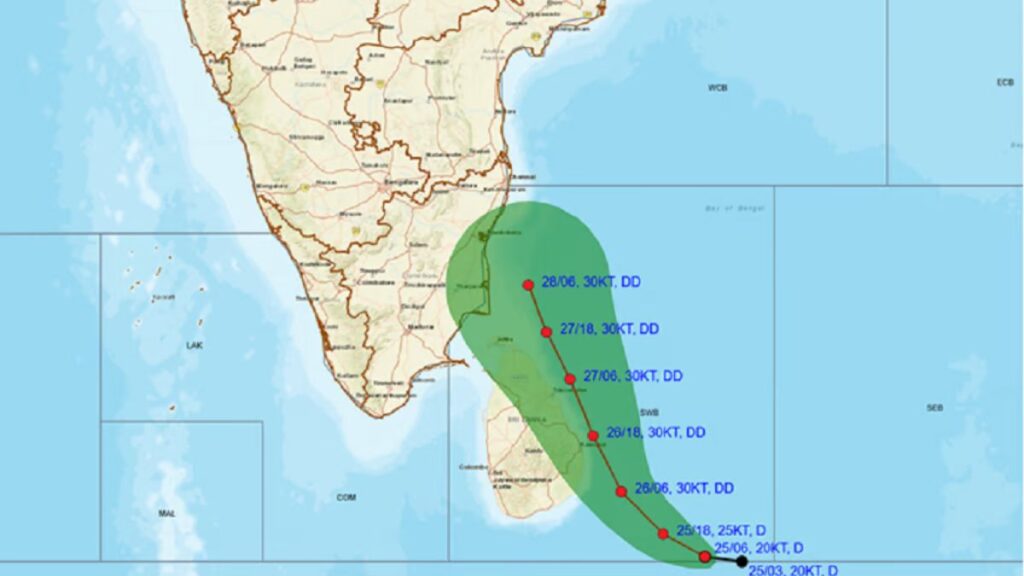List of cyclones that hit India during 2019-2024: See here the list of severe cyclones that hit Indian states during the years 2019-2024.
Since 2019, India has been hit by 27 storms, of which 23 caused minor impacts. Four were classified as severe, causing significant damage to infrastructure and livelihoods in the affected areas.
These tornadoes can bring heavy rainfall, strong winds and storm surges, posing a threat to coastal communities and requiring preparedness measures.
The strongest storm to hit India in the past 12 months was “Hamoon”. It made landfall near Saiha on October 24, 2023, at 11:30 pm local time, with wind speeds of up to 137 km/h and a diameter of 44 km.
According to the internationally recognized Saffir-Simpson scale, it is classified as a category 1 cyclone. On the open sea, wind speeds peaked at 148 km/h.
Let’s take a closer look at the cyclones that have affected India in recent years and the actions taken to minimize their impact.
Check:
- Cyclone GK Quiz: Test your knowledge about nature’s fury
- Cyclone Dana: What are you doing? जानें
List of cyclones hitting India from 2019 to 2024
India’s cyclone season is closely tied to the summer monsoon, with the most intense storms typically forming in the pre-monsoon (May to June) and post-monsoon (October to November) periods. .
Below is a list of destructive storms that have hit India from 2019 to present. Some of the most notable storms include:
Related stories
| Name of tornado | Day | Maximum intensity | Affected area | Damage (USD) | death |
| Cyclone Pabuk | January 4 – January 8, 2019 | Tropical storm | Andaman Sea | Minimum | Do not have |
| Cyclone Fani | April 26 – May 4, 2019 | Extremely severe (175 km/h) | Odisha, West Bengal | 8.1 billion USD | 89 |
| Cyclone Vayu | June 10 – June 17, 2019 | Very severe (135 km/h) | Gujarat | Reasonable | Do not have |
| Cyclone Hikka | August 6 – August 9, 2019 | Very severe (120 km/h) | Oman (minimal impact in India) | Minimum | Do not have |
| Cyclone Kyarr | October 24 – November 2, 2019 | Super tornado (220 km/h) | Arabian Sea (does not directly affect India) | Minimum | Do not have |
| Cyclone Maha | October 30 – November 7, 2019 | Extremely severe (150 km/h) | Arabian Sea (does not directly affect India) | Minimum | Do not have |
| Cyclone Bulbul | November 5 – November 11, 2019 | Very severe (110 km/h) | Odisha | Reasonable | Do not have |
| Cyclone Pawan | December 2 – December 7, 2019 | Tropical storm | Arabian Sea | Minimum | Do not have |
| Cyclone Amphan | May 16 – May 21, 2020 | Extremely severe (260 km/h) | West Bengal | 13 billion USD | 128 |
| Tornado Tauktae | May 17 – May 26, 2021 | Extremely severe (210 km/h) | Gujarat | 8.1 billion USD | 170 |
| Cyclone Yaas | May 23 – May 26, 2021 | Very severe (130 km/h) | Odisha | 610 million USD | Do not have |
| Cyclone Jawad | December 2 – December 6, 2021 | Very severe (120 km/h) | Andhra Pradesh, Odisha | Minimum | Do not have |
| Asani Cyclone | May 8 – May 12, 2022 | Very severe (130 km/h) | Andhra Pradesh | Minimum | Do not have |
| Cyclone Mandou | December 9 – December 12, 2022 | Very severe (120 km/h) | Tamil Nadu | Reasonable | Do not have |
| Cyclone Sitrang | October 22 – October 25, 2022 | Tropical storm | Assam, Odisha, West Bengal | Minimum | Do not have |
| Cyclone Biparjoy | June 6 – June 15, 2023 | Extremely severe (195 km/h) | Gujarat | 700 million USD | Do not have |
| Cyclone Remal | May 24 – May 28, 2024 | Severe (110 km/h) | Odisha | 600 million USD | Do not have |
| Cyclone Asna | August 25 – September 3, 2024 | Tropical storm | Madhya Pradesh | 30 million USD | Do not have |
| Cyclone Dana | October 24 – October 25, 2024 | Expected to be severe | Odisha, West Bengal | USD 72 million (Rs 600 billion) | Affected 14 districts in Odisha, affecting over 41 lakh people across 166 blocks. |
| Cyclone Fengal | November 25-November 27, 2024 | A deep recession is expected | Tamil Nadu and Puducherry | TBD | TBD |
Source: Worlddata.info
Cyclone Fengal is a developing tropical weather system currently forming over the southeastern Bay of Bengal and the adjacent Eastern Equatorial Indian Ocean.
As of November 26, 2024, the India Meteorological Department (IMD) reported that the system had strengthened from a low pressure area to a low pressure area and was expected to continue to strengthen, potentially making landfall. between Chennai and Puducherry in the next few days.
Formation and development
- Origin: Cyclone Fengal originated from a cyclonic circulation that developed near the South Andaman Sea on November 21, 2024. It transformed into a low pressure area on November 23 and was classified as a depression on November 24.
- Naming: The name “Fengal” was proposed by Saudi Arabia as part of a naming convention established by a group of 13 countries for cyclones in the region.
Expected pathways and impacts
Movement: The cyclone is currently moving in a north-northwest direction, with forecasts suggesting it will approach the coasts of Sri Lanka and Tamil Nadu. The storm is expected to make landfall between November 25 and 27, causing significant weather impacts to these areas.
Rainfall: Heavy to very heavy rainfall is expected in Tamil Nadu and Puducherry, with isolated areas likely to experience downpours. Rainfall can reach from 64.5 mm to more than 204.5 mm during this period.
Wind speed: Persistent winds are expected to reach speeds of up to 65 km/h, with gusts likely to reach 75 km/h, posing a risk to coastal operations and infrastructure.
Safety advice
The IMD has advised fishermen to avoid venturing into the sea as conditions are expected to be harsh. In addition, urban flooding can occur in areas with heavy rainfall, requiring local residents to take preventive measures.
Cyclone Fengal followed Cyclone Dana, which impacted Odisha on October 25, 2024. Unlike many cyclones that typically affected Andhra Pradesh or West Bengal this season, Fengal’s trajectory marked a southward shift India, specifically targeting Tamil Nadu and Sri Lanka.
Also read| How are tornadoes named around the world?
![[Updated] List of Cyclones that hit India from 2019 to 2024](https://truongmamnontrucviet.edu.vn/wp-content/uploads/2024/11/Updated-List-of-Cyclones-that-hit-India-from-2019-to-1024x536.jpg)

